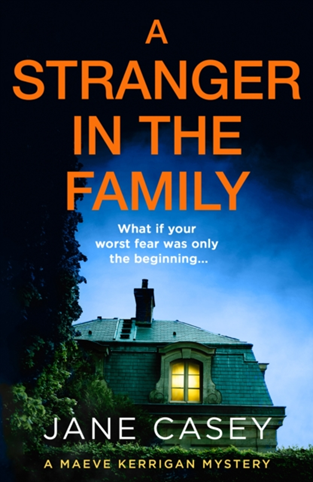Queen Maeve Kerrigan
- robyncoombes
- Mar 15, 2024
- 7 min read
Updated: May 29
“much Irish crime fiction blurs genre boundaries promiscuously” (Brian Cliff 14)

Despite the title of this blog ('Season's Readings'), I don't actually curate my reading habits to suit the seasons. Hence, mid-unprecedented-Irish-heatwave, I have not been reading beachy romcoms as much as perhaps I should.
If you’ve read my last post, you’ll know that I’ve

recently become a chain smoker of crime fiction. Tana French’s Dublin Murder Squad series, (which I've only just completed) is dangerously addictive. Despite its unrelentingly dark plot (and disturbing resolution), Broken Harbour, the fourth in the series, is a compelling package of dynamic writing and characters. Set in a ghost estate on the outskirts of Dublin post-economic crash, this aptly chilling site is populated by “all the people who should have lived here” (187). In this uncanny environment, abandoned scaffolding stands as an ineffectual frontier against nature, and holes in walls mirror the cracks in their owners’ facades, inviting us deeper into a world of instability and mental collapse. With the sea a spectral presence, and site of trauma for Detective ‘Scorcher’ Kennedy and his family, French summons the haunting margins into this claustrophobic world of manmade failure.
Rather than transforming the identity of the seaside village of Broken Harbour, the Celtic Tiger and its aftermath have seemingly displaced it. The past is so erased that Scorcher’s satnav “didn’t know where Broken Harbour was. It wanted to go to Brianstown” (7). Here natural environments are macadamised, and buildings left as hollow, uninhabited shells. Though Brianstown estate is seemingly named for newness, it is a superficial plaster over the past by a developer “playing little emperor” (395). French here suggests the older colonisation of Ireland, with the brochure fabrication of Brianstown in some ways echoing the failure of the fadó fadó plantations. Yet the Broken Harbour of Scorcher’s childhood is itself derived from breacadh, the Irish for ‘daybreak’ (185), reminding us of the subsuming effects of colonialism whereby many Irish placenames (logainmneacha) were not faithfully translated into English, but anglicised phonetically. A classic example is Dublin – from Dubh Linn, or Black Pool - yet its Irish name, Baile Átha Cliath, means ‘town of the hurdled ford’. Similarly, Baile an tSagairt translates to Priest’s Town, but its Anglican name, Ballintaggart, is essentially meaningless. And so on. As Irish placenames were discarded, their linguistic origins and unique identities were gradually forgotten. What’s in a name? Quite a lot, William.
When Scorcher reminisces; “‘This was a fishing village, a long time back’” (185), all that remains of that history is the primordial sea itself – “The smell of the sea swept over the wall and in through the empty window-hole, wide and wild with a million intoxicating secrets. […] It hooks us somewhere deeper than reason or civilisation, in the fragments of our cells that rocked in oceans before we had minds, and it pulls till we follow mindlessly as rutting animals” (185-6). Now an air of uncanniness prevails – “The houses were too much alike” (15) – and like Freud’s metaphoric journey through “devious paths” and “mountain mist” (“The ‘Uncanny’”, 11), the estate is “like one of those old hedge-mazes, all cul-de-sacs and hairpin turns, and almost straightaway we were lost” (16).
There is a lot to analyse in the relation between place and psyche in this novel, but that’s for an actual critic to discuss. Like Shirley Peterson, who argues that French’s series transcends the traditional conventions of the detective genre and its associated explorations of trauma, to become trauma novels. Though they present the usual jigsaw of clues, they rarely arrive at “an objective and rational ‘truth’” (109), instead leaving some things “unexplained, which might suggest a flaw in these detective narratives. However, as trauma novels these narrative lacunae dramatize well the difficulty of integrating traumatic experience into the realm of narrative memory” (116). Into these lacunae, like those mysterious holes in Brianstown’s walls, certainty and generic conventions disappear.

But as Brian Cliff claims that “much Irish crime fiction blurs genre boundaries promiscuously” (14), I’m here to talk about the most delightfully philandering (though not as much as we stans might wish) series of detective novels by Jane Casey. I grant these books alone the power of making me reassess the name Maeve - (Sex Education could never). Yes, I know its regal roots (Queen Medb? Meadhbh? Méabh? Méibh? Speaking of anglicised …), but it was filed under unappealing Irish names for me until the striking DC (now DS) Maeve Kerrigan strode onto the crime scene with her enviably long legs. Though Maeve endures “misplaced gossip” - “assumptions made about me based on my look, my height, my youth, my name” (The Reckoning 4) - the ambitious detective, born and raised in London to Irish parents, possesses a likeability like no other. She is “one of the most thoroughly human and convincing police officers in the fictional ranks” according to Laura Wilson writing for The Guardian, and part of this authenticity stems from her rounded background and realistically rendered dual identity - “I was Irish to English people and English to Irish people and I never truly felt I belonged in either society” (37). This outsider status is a classic conceit of the literary detective that confers objectivity, while mirroring the reader’s own position on the margins. But as Elizabeth Mannion states, “[w]hile her cultural space might be liminal, her professional standing is unambiguous. She is a valuable member of the murder squad, both for her insights into reading people and for her attention to detail: she is an astute observer” (122).
Yet for all her perception as a detective, not to mention “her self-consciousness, Maeve is relatively void of self-awareness” (Mannion 130). Cue an addictive and “long-running will-they-won't- they-would-they-ever routine” (Hughes, "Irish Queens”) between Maeve and her boss, “the chiselled, mercurial and fiercely clever DI Josh Derwent” (Kirwan). As Shilpa Ganatra agrees, this “friction between her frenemy and professional partner … is another reason to keep turning pages” - (readers, including myself, horse into these books not merely for the satisfying resolution of complex cases). Introduced in the second novel, The Reckoning, Casey intended Derwent to be a one-book-and-done character, but true to form and thanks be to God, he swaggered his way into book three and never left. Hands down the most enjoyable character I have ever read, Derwent presents the perfect foil to Maeve’s curiously low self-esteem with his suave confidence and unfailing arrogance. Yet because Casey presents a brilliantly layered and evolving character, Maeve’s opinion transforms from being “intimidated and unsettled by him, unsure how to cope with the force of his personality and the way he liked to challenge” (Close 122), to finding him “strangely endearing” (Stranger 197), to, well I won’t spoil it. Declan Hughes says it best, this series is “utterly intoxicating” ("Irish Queens”), and certainly blurs those traditional definitions of the detective genre. It is as Hughes contends, a “delirious conceit, which could be the premise for a romantic comedy” ("Irish Queens”), or as Catherine Kirwan calls it, “an exquisite torture”. I am writing this on the day of publication for A Stranger in the Family, the eleventh in the series. Knowing I’ll have another year to wait for the next instalment, I will try to delay gratification for as long as humanly possible. Just knowing there is yet unread Maeve-Josh material out there keeps me going. My future self is jealous of my present self.
Jane Casey’s Maeve Kerrigan series in order:
Novels: Short Stories/E-Books:
0.5 “Left for Dead” (2013)
1 The Burning (2010)
2 The Reckoning (2011)
3 The Last Girl (2012)
4 The Stranger You Know (2013)
5 The Kill (2014)
6 After the Fire (2015)
7 Let the Dead Speak (2017) 7.5 “One in Custody” (2019)
8 Cruel Acts (2019) 8.5 “Love Lies Bleeding” (2019)
9 The Cutting Place (2020) 8.75 “Silent Kill” (2020)
10 The Close (2023) 10.1 “The Dirty Dancing Experience” (2024)
11 A Stranger in the Family (2024) 10.5 “The Outsider” (2023)
Or you could try the order I read them: 4, 6, 5, 9, 1-10
Bibliography
Casey, Jane. The Close. HarperCollins, 2023.
---. The Reckoning. Ebury Press, 2011.
---. The Stranger You Know. Ebury Press, 2013.
Cliff, Brian. "At Home in Irish Crime Fiction." Clues, vol. 39, no. 1, 2021, pp. 13-23. ProQuest,
fiction/docview/2713633900/se-2.
French, Tana. Broken Harbour. Hodder & Stoughton, 2018.
Freud, Sigmund. “The ‘Uncanny’.” First published in Imago, Bd. V., 1919; reprinted in
Sammlung, Fünfte Folge, translated by Alix Strachey. Accessed at
https://web.mit.edu/allanmc/www/freud1.pdf, pp. 1-21.
Ganatra, Shilpa. "A criminal mastermind: While the UK faces an exodus of its international
population as Brexit materialises, Irish crime writer Jane Casey has swum against
the tide to settle back in London, she tells Shilpa Ganatra." Irish Times, Apr 27, 2019,
pp. 17. ProQuest, www.proquest.com/newspapers/criminal-
mastermind/docview/2215410132/se-2.
Hughes, Declan. "Another Irresistible Kerrigan Book from Jane Casey: In Casey’s Latest,
the Pace is Relentless, the Misdirection Artful and Ingenious." Irish Times, 20 Apr,
2019, pp. 28. ProQuest, www.proquest.com/newspapers/another-irresistible-
kerrigan-book-jane-casey/docview/2211476512/se-2.
---. "Irish Queens of Crime Fiction Rightly Take the Laurels." Irish Times, 18 Mar, 2023, pp.
take-laurels/docview/2787741342/se-2.
---. "Meet Maeve Kerrigan, my favourite detective." Irish Times, Mar 25, 2017, pp. 13.
detective/docview/1880589563/se-2.
Kirwan, Catherine. "Book review: Crime meets romance as Maeve series turns up
heat." Irish Examiner, Mar 05, 2023. ProQuest,
maeve-series/docview/2782781708/se-2.
Mannion, Elizabeth, editor. The Contemporary Irish Detective Novel. Palgrave Macmillan,
2016.
---. “‘Irish by blood and English by accident’: Detective Constable Maeve Kerrigan.” The
Contemporary Irish Detective Novel, pp. 121-134.
Peterson, Shirley. “Voicing the Unspeakable: Tana French’s Dublin Murder Squad.” The
Contemporary Irish Detective Novel, pp. 107-120.
Wilson, Laura. “The best recent crime and thrillers – review roundup.” The Guardian, 22
review-roundup.




Comments